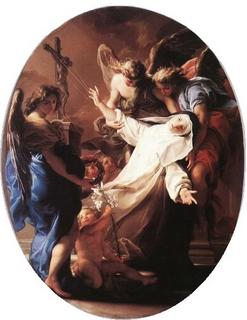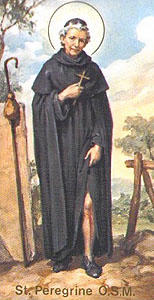 St Teresa of the Andes
St Teresa of the Andes
Patronage: bodily ills, illness, sick people, sickness, young people in general
Before entering Carmel in 1918, a young eighteen year old Chilean girl, attracted by Christ, explained thus to her hurt and scandalized brother the reasons for her vocation: "There is, in the soul, an unquenchable thirst for happiness. I want to love something infinite, and I do not want the one I love to change or be a plaything of its passions, circumstances of time and life. Love, yes, but love the immutable Being, God, who has loved me infinitely from all eternity." The natural desire for happiness is of divine origin; God put it in man's heart in order to draw him to Himself who alone can fulfill it.
On March 21, 1993, at the canonization of Saint Teresa of the Andes, Pope John Paul II declared: "To a secularized society which lives with its back turned to God, I have the joy to present, as a model of the everlasting youth of the Gospel, this Chilean Carmelite. She brings to men of today the limpid witness of a life which proclaims that it is in the love, adoration and service of God that grandeur and joy, freedom and the full realization of the human creature are found. The life of Blessed Teresa cries out softly from the cloister: God alone suffices!"
Juana Fernandez Solar was born on July 13, 1900 in a well-to-do family of Santiago, Chile (Latin America). From her childhood she manifested an ardent personality, full of heart and intelligence and animated with a great desire for God.
In spite of these good dispositions, Juana did not lack defects. She was stubborn, vain and egoistic, given to pouting and whims. "I sometimes went into a ferocious rage," she would later say. With the help of her family (she had five brothers and sisters) and especially by the grace of her Baptism, she led a tough battle against her inclinations, especially against her hot and emotional temper, which was influenced by her fragile health. One day, her sister Rebecca was so taken away with Juana that she hit her with all her strength. Juana wanted to strike back with the same vigor but instead she kissed her. Victorious over her anger, Juana went meekly away.
Since then, my Jesus speaks to me. I did everything with Jesus and for Jesus."
On December 8, 1915, with the permission of her confessor, Juana consecrated herself to God by the vow of chastity. In 1916, Juana made her first retreat according to the method of Saint Ignatius of Loyola. After meditating on the "Call of Christ the King," she wrote: "Be disposed to follow Jesus wherever He wants. He chose poverty, humiliations, the cross. In spite of her trials and illnesses, Juana remained a joyful and friendly young girl.
Juana heard God's call: "How happy I am, my dear little sister!" she wrote Rebecca on April 15, 1916. "Each day I long to go to Carmel to be occupied with Jesus alone, to be merged into Him and no longer live but on His life: to love and suffer to save souls. Yes, I thirst for souls because I know that is what my Jesus loves most. The demands of conversion concern all the children of the Church. By the vow of poverty, they forsake the personal possession of earthly goods; by the vow of chastity, they renounce marriage; by the vow of obedience, they surrender legitimate autonomy in the direction of their life. This absolute love is a valuable example for all Christians.
In September 1917, Juana wrote to the Prioress of the Carmelite Convent of Los Andes, situated at the foot of the mountain range of the same name, 70 km from Santiago, and expressed her desire to enter the convent. "The life of a Carmelite is suffering, love and prayer, and such is my ideal. My Reverend Mother, my Jesus has taught me these three things ever since my childhood."
In the spring of 1918, she offered herself as a victim of love and expiation, in answer to an inspiration of the Sacred Heart of Jesus. Shortly afterwards, her soul was shrouded in darkness. She confided to a priest her state of interior suffering, adding: "I am not surprised, my Reverend Father, because I have asked Christ to deprive me of all consolation, so that other souls whom I love may find peace and joy in the sacraments and prayer."
The redemptive Passion of Christ has conferred a new meaning upon suffering which is a consequence of original sin: it can now be a share in the salvific work of Jesus. There is a constant bond of love and an abundant exchange of all goods among the faithful-those in Heaven, in Purgatory and on the earth-which is called the communion of saints. On January 11, 1919, Juana and her mother visited the Carmelite Convent of Los Andes, chosen because it was the poorest in Chile.
Mrs. Fernandez had been observing the action of grace in her daughter's soul. In the spring of 1919, Juana, wrote to her father in order to obtain his consent. Going against the natural instincts of his heart, he answered, "My child, if such is the will of God, I am not opposed." Filled with joy, Juana exclaimed: "Saint Joseph has done the miracle!"
On May 7, 1919, the doors of the Carmel of Los Andes closed behind the postulant who would be called Sister Teresa of Jesus, Teresa of the Andes. "Blessed be God," she wrote to her mother the following day. "I am in my little convent. I am taking great care to walk in wooden shoes. In every religious community, poverty is in honor. Without denying the worth of created goods, voluntary poverty places them in their true, contingent perspective. Its first meaning is to bear witness to God who is the true wealth of the human heart, out of imitation of Christ in poverty: Blessed are the poor in spirit: for theirs is the kingdom of Heaven (Mt 5: 3). In a materialistic world so often eager to possess, oblivious to the needs and sufferings of the weakest, evangelical poverty forcefully exposes the idolatry of money.
On October 14, 1919, Sister Teresa received the Carmelite habit, in the presence of her family and a number of friends. At the beginning of March 1920, Sister Teresa affirmed that she would die in a month. On the 12th, after just eleven months of Carmelite life, Sister Teresa of Jesus entered into the joy of Heaven.
The influence of Saint Teresa of the Andes is surprising for a young girl who died at the age of twenty. Her life, inconspicuous for a society impressed with temporal success, is nevertheless proposed by the Church as an example of human achievement. The secret of Chile's saint is found in her deep union with Christ and in the practice of true love, poured forth in our hearts, by the Holy Ghost, who is given to us (Rm 5: 5). This Love, unlike the false love which seeks egoistic pleasure, is identified with the gift of self without counting; it procures true happiness for man.
When I love, it’s forever. A Carmelite never forgets. From her small cell, she accompanies the souls she has loved in the world' (August 1919). Teresa's burning love moved her to long to suffer with Jesus and like Jesus. `We are co-redeemers of the world, and the redemption of souls is not accomplished without the cross'
Pope John Paul II declared at her canonization: "God made the light of His Son Jesus Christ shine in her in a wonderful fashion, so that she might be a beacon and a guide for a blind world which is incapable of discerning divine splendor To youths who are continually being attracted by the messages and suggestions of an erotic culture, to a society which confuses authentic love which is the gift of self, with the hedonistic use (for one's own pleasure) of others, this young virgin of the Andes proclaims the beauty and the happiness which flows from pure hearts.
Some thoughts of St Teresa of Los Andes"Who can make me happier than God? I find all things in Him.
"Always look for God. In Him is the source of all bliss. Apart from Him, happiness is impossible. God alone suffices... Men's hearts love one day and on the next they are indifferent. God alone never changes.
I shall take great pains to work for the happiness of others... My resolution: to sacrifice myself for others.... I must strive to be more loving.
A believing soul possesses all things because it possesses God... Everything changes when you look at this divine Sun... With faith, sufferings are transformed.
When you are in love, everything is a joy; the cross is no burden and you are unaffected by martyrdom; you live in heaven rather than on earth.
How your life would be transformed if you went to Jesus often as to your intimate friend!
Let us take notice of our neighbour and serve him, even though we find it repugnant to do so. In this way we will find that the throne of our heart will be occupied by its Owner, by God.
In the shadow of the Cross, all bitterness vanishes... Souls are shaped on the anvil of sorrows.
To lovingly offer ourselves to the Father in order to accomplish his adorable will. This I reckon is the plan of holiness.
God is thirsting for the love of His creatures. The same God is our beggar. Let us give ourselves to Him. Let us not be mean... Let us not look at what we are doing, but at the extent of our failure to correspond to His love.
Always take the Most Blessed Virgin as your model. Speak to her, heart to heart... Ask her to be your guide, to be your star, the lighthouse which shines in the midst of the darkness of your life.












